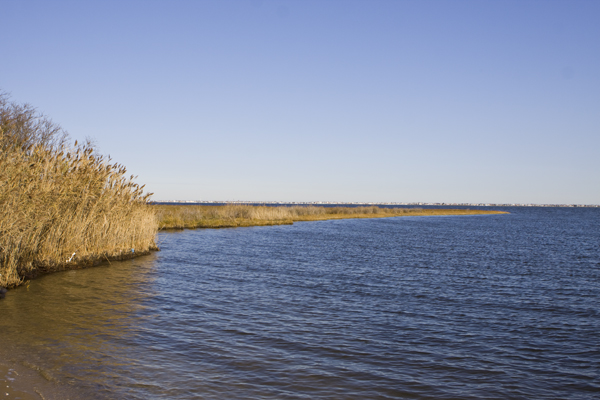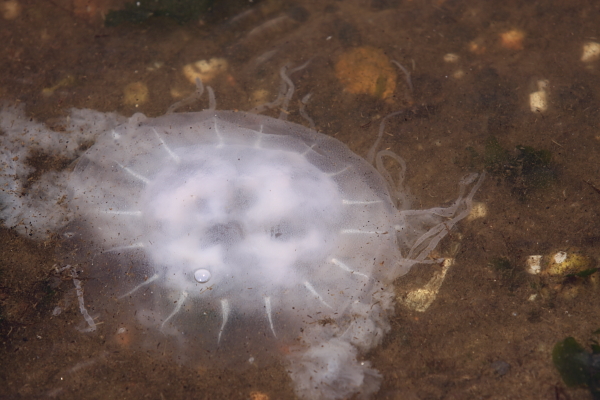
Jellyfish - current symbol of decline of ecological health of the Barnegat Bay. But what's next?
Everybody knows that the dice are loaded
Everybody rolls with their fingers crossed
Everybody knows that the war is over
Everybody knows the good guys lost
Everybody knows the fight was fixed
The poor stay poor, the rich get rich
That’s how it goes
And Everybody knows ~~~ “Everybody Knows”Leonard Cohen (1988)
Yesterday, the annual special summer shore session of the joint Senate and Assembly Environment Committees released a package of four bills purportedly designed to stop the decline and restore the ecological health of Barnegat Bay. DEP failed to testify.
The following report on the hearing is provided in three parts – please hit the links for important information: Part I, Background; Part II, Problem Diagnosis; and Part III, Proposed Solutions.
I) Background
The hearing was standing room only, packed with about 300 or more Bay supporters. The turnout was the result of years of campaigning and an all out organizing effort by all of NJ’s leading environmental groups. From senior citizens to kids dressed up as jellyfish, the turnout was a powerful expression of public support for doing something real to “save the Bay” .
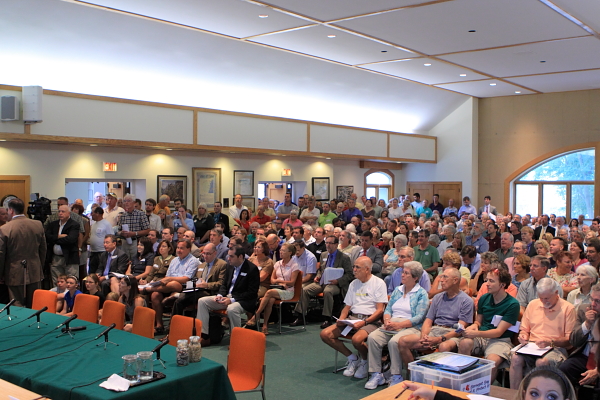
standing room - and sitting room only!
The hearing was preceded by a week-long page one outstanding in depth investigative news series of the Bay’s problems by the Asbury Park Press, written by NJ’s most veteran environmental reporters, Kirk Moore and Todd Bates – see “Barnegat Bay Under Stress”.

several kids dressed as jellyfish - they entered the room to a round of applause!
The hearing follows a summer where jellyfish have proliferated in the Bay to the point that they have become an extreme nuisance, and very visible indicator of the Bay’s declining ecological health.
NBC TV NY affiliate reporter Brian Thompson summed it all up in this broadcast: “Stinging Jellyfish, Dead Bunker Fish, Dangerous Oysters: NJ Coast Under Stress”
Last August, another joint hearing took testimony from a series of experts on the Bay’s declining health. Scientific and political consensus emerged that the Bay was dying (see “All Quiet on the regulatory front – DEP sits on sidelines as Barnegat Bay is dying“).
During and in the wake of that August 2009 hearing, on a bipartisan basis, legislative leaders of both Senate and Assembly Committees supported and promised a legislative package.
Since then, Republican Governor Christie, during the campaign and again as Governor, acknowledged the critical importance of the Bay and made commitments to protect it.
Opponents were dealt a weak hand, forced to work behind the scenes, and mounted no credible public opposition.

Earth Day, 2010 - With his daughter Bridget at his side, Gov. Chris Christie announced at the Surfrider Beach Club in Sea Bright on Thursday that he is opposed to offshore drilling. (PHOTO: BRADLEY J. PENNER)
In other words, there were supremely optimum conditions present to achieve a major victory in securing real legislative, regulatory, institutional, and financial commitments to restore the Bay.
Environmentalists could have asked for the sun, moon, stars, and the planets – and gotten most of it.
It just doesn’t get any better – science, politics, public support, media, and visible evidence of the problem. Comparatively, these conditions were far better than those that have led to other major NJ environmental victories, most recently like the Highlands Act.
But despite this optimistic context, regretfully, I have to write about a total failure and huge missed opportunity that is being falsely praised in media circles and perversely celebrated as significant progress among Barnegat Bay supporters and activists.
And I am not talking here about legitimate disagreements over a political compromise legislative package, where the legitimate disagreements are over whether the package goes far enough or fast enough.
No, I am talking about fatal design flaws and omissions, some of which were known in advance, and thus suggest either cynical politics or cowardice. So let’s break those issues out:
II) Problem diagnosis ignores known management failures
Since 1995, the management of Barnegat Bay has been under the National Estuary Program. DEP and EPA have largely deferred to the local BBNEP process, which has replaced traditional federal and state roles.
The NEP model relies on a voluntary, local, market based and consensus “partnership” approach to management, in-lieu of mandatory federal and state regulatory requirements available under the Clean Water Act.
Instead of rehashing the legislative history that led to the NEP in 1987 and the Whitman Administration’s designation of Barnegat bay for the NEP Program in 1995, here is EPA’ view of the approach of the NEP (Note: this occurred at the apex of the ideological period in which policymakers and industry lobbyists disparaged “regulatory command and control” while seeking “third way” local, corporate, voluntary, and market based approaches to environmental problems)
EPA explained in “About the National Estuary Program”:
The National Estuary Program was established in 1987 by amendments to the Clean Water Act to identify, restore, and protect nationally significant estuaries of the United States. [View the authorizing legislation. Read about the program’s 10th Anniversary.] Unlike traditional regulatory approaches to environmental protection, the NEP targets a broad range of issues and engages local communities in the process. …
The National Estuary Program is designed to encourage local communities to take responsibility for managing their own estuaries. Each NEP is made up of representatives from federal, state and local government agencies responsible for managing the estuary’s resources, as well as members of the community — citizens, business leaders, educators, and researchers. These stakeholders work together to identify problems in the estuary, develop specific actions to address those problems, and create and implement a formal management plan to restore and protect the estuary.
As such , the NEP model is a political compromise and alternative to the more powerful regulatory tools available under the federal and state Clean Water Acts.
The BBNEP has done excellent scientific studies and technical work, but it has failed miserably in managing the protection and restoration of the Bay. This failure is because it lacks effective legal and political power, enforceable management tools, and resources required to get the job done.
It is time to admit that and design solutions that reflect that knowledge.
These failure were brought out in a 2004 Washinton Post story that revealed that EPA was intentionally misleading Congress and the public about alleged progress being made in Chesapeake Bay titled: “Bay Pollution Progress Over-stated – Government Program’s Computer Model Proved Too Optimistic”. But that optimism was in bad faith:
Several scientists affiliated with the Chesapeake Bay Program said the water monitoring reports offer a more reliable measure of pollution reduction than the computer estimates that the program has used.
“Basically, what we’re seeing is that the government has had its thumb on the scale for years,” said J. Charles Fox, former secretary of the Maryland Department of Natural Resources. “There’s no question now that the government was inflating progress in the Chesapeake Bay.”
He attributed the overstatements to “an institutional bias to show progress.”
The WaPo story led to a General Accounting Office Report –
The GAO Report: “Chesapeake Bay Program: Improved Strategies are Needed to Better Assess, Report, and Manage Restoration Progress” prompted US EPA to acknowledge the weaknesses of the NEP in the Chesapeake Bay.
Congressional oversight also forced EPA to admit that they had been misleading Congress and the public for years about the performance of the Chesapeake NEP.
So where is the critical legislative oversight by the NJ legislature on very similar failures in Barnegat Bay? Where is the Governor? Where is DEP Commissioner Martin?
To respond to the Chesapeake crisis, on May 29, 2009, President Obama issued an Executive Order titled: “Chesapeake Bay Protection and Restoration” (a must read!).
The Obama Order: a) revoked the NEP program lead, b) federalized the Chesapeake management effort under EPA lead control, c) invoked Clean Water Act regulatory tools, and d) assured progress, performance, and accountability by mandating legally enforceable standards and numeric pollution reduction goals and timetables for action. The Order said:
Despite significant efforts by Federal, State, and local governments and other interested parties, water pollution in the Chesapeake Bay prevents the attainment of existing State water quality standards and the “fishable and swimmable” goals of the Clean Water Act. At the current level and scope of pollution control within the Chesapeake Bay’s watershed, restoration of the Chesapeake Bay is not expected for many years. The pollutants that are largely responsible for pollution of the Chesapeake Bay are nutrients, in the form of nitrogen and phosphorus, and sediment. These pollutants come from many sources, including sewage treatment plants, city streets, development sites, agricultural operations, and deposition from the air onto the waters of the Chesapeake Bay and the lands of the watershed.
Restoration of the health of the Chesapeake Bay will require a renewed commitment to controlling pollution from all sources as well as protecting and restoring habitat and living resources, conserving lands, and improving management of natural resources, all of which contribute to improved water quality and ecosystem health. . The Federal Government should lead this effort.
EPA Administrator Lisa Jackson recognized that priority by appointing a “Czar” named Chuck Fox to lead the effort. Fox is a well respected environmentalist and former EPA Assistant Administrator for Water, Secretary of Maryland’s DNR, and Pew Environmental Group oceans expert (full disclosure: I worked at Pew when Fox was there).
EPA has invoked the Clean Water Act’s TMDL (Total Maximum Daily Load) program as the primary tool restore the Bay.
But instead of learning from the Chesapeake and the same mistakes made in NJ’s Barnegat Bay, we are repeating mistakes made because we fail to admit them.
Worse, we failed to propose reforms that can address these failures and provide adequate tools to solve the problems.
Shockingly, NJ environmental groups seem either totally ignorant of this entire major policy debate, or are willing co-conspirators in their own manipulation in failing to protect the Barnegat Bay.
III) Proposed Solutions – a quick and dirty on the four bill package
1) Soil compaction – (click for bill, S 1410)
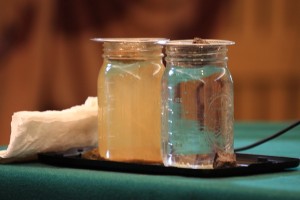
Ocean County SCS provided a simple illustration of the impacts of soil compaction. Water on right has natural chunk of soil, while jar on left has compacted chunk of soil.
A 2001 Ocean County Soil Conservation Service Report documented the problems associated with compacted soils. Compacted soils behave more like pavement than natural soils.
When it rains, this results in loss of groundwater recharge, lots of stormwater runoff, soil erosion, sedimentation, destruction of streams, flooding, destruction of habitat, pollution, and reduction of critical freshwater inputs to the Bay.
The Bay has lost over 30% of freshwater inputs from groundwater, streams, and rivers, which increases the temperature and salinity of the Bay, as well as increasing pollution concentrations (via less available dilution) that cause the eutrophication that is killing the Bay.
The biggest casue of soil compaction is the way builders develop on a site and use equipment – site preparation, construction, soil stockpiling, and demobilization are what compact the soil and cause the problem.
Yet NONE of these activities are regulated by the bill!
The bill only applies to post construction activities and restoration plans – it does not prevent or minimize soil compaction in the first place or limit construction practices that cause the problem.
As a result, it will not achieve its stated objectives. It is designed to fail.
In addition, the Monmouth County Health Department identified significant flaws in DEP water quality standards and monitoring and assessment programs that regulate the water quality aspects of the problems associated with soil compaction and stormwater runoff.
We disclosed both the Ocean County SCS soil compaction work and the Monmouth County criticism three years ago in this Report:
NEW JERSEY WATER TESTS UNDERSTATE POLLUTION – County Complains Standard Does Not Truly Measure Development Impacts
Yet the bill fails to address the serious flaws documented by Monmouth County, to direct DEP to correct or respond to those flaws, or to apply revised DEP standards to the soil compaction related and restoration plan water quality issues addressed by the bill.
Without soil compaction activities and site restoration plans subject to legally binding scientifically valid and enforceable DEP water quality standards, the bill will not achieve it stated objectives.
2) Stormwater Utility (2 inter-related bills – S 1815 and S 1856)
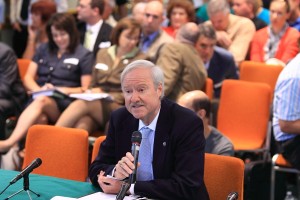
Ocean County Freeholder Bartlett strongly opposed stormwater utility legislation. His demagoguery was called out by Chairman Smith.
I will only say one thing on this topic.
The bill is enabling, or permissive, i.e. it merely allows Ocean County to develop and adopt the stormwater utility program outlined in the legislation. Ity does not mandate that they do so.
Accordingly, for the legislation to be effective, it must be supported and embraced by Ocean County.
But Ocean County Freeholders and Planning Board strongly, vehemently, and in arrogant detail flat out rejected the bill.
Senate Chairman and sponsor Bob Smith got in a rather nasty exchange with Freeholder Bartlett, who, topping off his rant in opposition to the bill, claimed that Smith was so arrogant he didn’t even reach out and meet with Ocean County officials.
Smith took exception to that and interrupted Bartlett. Correcting Bartlett, Smith said he met with Ocean County’s business adminsitrator and Chief engineer and was told that the Freeholders “wanted no part of the legislation”.
Smith knew this before the hearing.
Yet despite this knowledge Smith – and NJ environmental groups – went with and continue to back a bill they know will not work and continue to ignore a stronger Clean Water Act TMDL based approach that they know can work.
Aside from totally failing in the Chesapeake Bay and the Barnegat Bay, the approach of merely enabling local officials to manage critical natural resource protection programs that involve raising local revenues via taxes or user fees has been rejected in Morris County (Lake Hopatong Commission) and Passaic (Greenwood Lake Commission).
The enabling approach of the legislation is designed to fail.
3) fertilizer nitrogen controls – (S 1411)
I am not up to speed on fertilizer issues and reserve comment.

Assemblywoman Coyle carried fertilizer industry water during hearing. She was not alone.
However, I will note two things.
First, legislators sat silent like bumps on a log – asking no questions and making no comment – during hours of pubic testimony about the declining health of the Bay and the adequacy of the proposed solutions.
But they woke up and they strangely became animated and chock fill of detailed questions when the fertilizer bill was up.
It was obvious – and disgusting – to see the degree of influence that fertlizer industry lobbyists have and who legislators listen to. Their behavior was an indictment of democracy – a handful of lobbyists had far more influence that thousands of people concerned about the Bay.
Second, and more important, it is important to note that nitrogen pollution loads to the Bay come from many more sources than fertilizer applications and that it is the total load of nitrogen (and other pollutants) that are killing the Bay.
Regardless of time release or percentage of the nitrogen content, a fertilizer ordinance CAN NOT ADDRESS TOTAL NITROGEN LOADINGS.
However, a TMDL under the Clean Water Act would require that all sources of nitrogen loadings are identified and quantified. A TMDL would set a comprehensive science based numeric “total load” or cap on total nitrogen loading to the bay from all sources. A TMDL would legally mandate pollutant load reductions.
The TMDL regulatory approach is FAR superior to a fertilizer ordinance based approach because it addresses all sources, sets numeric regulatory requirements and load reduction timetables, is measurable, and therefore far more effective than the fertilizer ordinance approach.
4) Critical Issues Not Addressed
In addition to all this failure by design, the legislative pacakge does NOT address the followign issues that are killing the bay:
a) over-development – the unrestricted build-out allowed under local zoning in the watershed is monstrously large and totally unsustainable. It is the elephant in the room. As I testified, this exact finding by the US Forest Service Highlands report was the lynch-pin to enactment of the Highlands Act ;
b) freshwater supply and inputs to the bay – aquifer depletion, saltwater intrusion, loss of freshwater inputs to the Bay, and long term water supply deficits are ignored (the shore already has trouble meeting demand and we are entering another drought). Where is the water going to come from to support all that development? What are the ecological and economic costs of that?
c) ocean discharges from regional sewer plants deplete the groundwater. At least 30% of that water needs to be recharged on land to offset loss of freshwater to the bay, but only after pollution treatment upgrades.. AND last, but not least,
d) Oyster Creek cooling towers! See:
Christie Back-pedaling on “Commitment” to Oyster Creek Nuke Cooling Towers To Protect Barnegat Bay
e) Update: infrastructure financing plan – show me the money!
No wonder DEP failed to testify!
Everybody knows that the boat is leaking
Everybody knows that the captain lied
Everybody got this broken feeling
Like their father or their dog just died
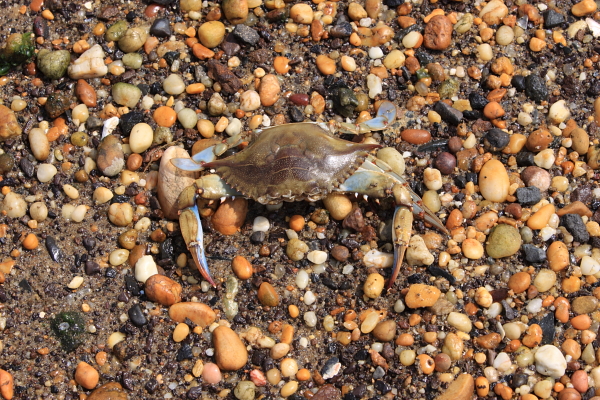
Blue crab
